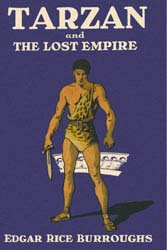Tarzan and the Lost Empire
 From Wikipedia the free encyclopedia
From Wikipedia the free encyclopedia
 Dust-jacket illustration of Tarzan and the Lost Empire | |
| Author | Edgar Rice Burroughs |
|---|---|
| Illustrator | A. W. Sperry |
| Country | United States |
| Language | English |
| Series | Tarzan series |
| Genre | Adventure |
| Publisher | Metropolitan Newspaper Services |
Publication date | 1928-1929 |
| Media type | Print (hardback) |
| Pages | iii, 313 |
| Preceded by | Tarzan, Lord of the Jungle |
| Followed by | Tarzan at the Earth's Core |
Tarzan and the Lost Empire is a novel by American writer Edgar Rice Burroughs, the twelfth in his series of twenty-four books about the title character Tarzan. The story was first published as a serial in Blue Book Magazine from October 1928 through February 1929; it first appeared in book form in a hardcover edition from Metropolitan Newspaper Services in September 1929. This was the first Edgar Rice Burroughs book not published by A. C. McClurg, with whom Burroughs had cut off business ties due to a dispute over royalties.[1]
Plot[edit]
Erich von Harben, a young German specialized in archaeology and dead languages, with a passion for mountain climbing starts investigating the legend of The Lost Tribe of the Wiramwazi Mountains and disappears. His father meets and asks Tarzan for help.
Tarzan in his search for Erich von Harben finds a lost remnant of the Roman Empire hidden in the mountains of Africa. They are inhabitants of two rival cities Castra Sanguinarius, ruled by Sublatus Imperator, and Castrum Mare, ruled by Validus Augustus.
Erich von Harben was captured and brought to Castrum Mare, where he meets Mallius Lepus, who takes him to his uncle, Septimus Favonius, introducing him as a barbarian from Germany. Erich von Harben falls in love with Favonia, the daughter of Septimus Favonius and makes an enemy of Fulvus Fupus.
Tarzan reaches Castra Sanguinarius, the city being ruled by Sublatus Imperator. Trying to get information about von Harben, Tarzan makes an enemy of the Emperor and his son Fastus. Protecting Dilecta, the daughter of Dion Splendidus, from Fastus he makes a friend out of Maximus Praeclarus, the young patrician officer who brought him to Castra Sanguinarius. Maximus hides him in his house.
Betrayed by a servant, Tarzan and Maximus Praeclarus are captured and chained in the dungeons beneath the Colosseum of Castra Sanguinarius. Here he meets Cassius Hasta, the nephew of Validus Augustus. They fight as gladiators against man and beast and win in the end. Still the emperor does not grant them their freedom. With help of Appius Applosus, a friend of Maximus they escape and lead a revolution against Sublatus with help of the slaves from the nearby villages and the Waziri, brought by Nkima. Once Sublatus is defeated, Tarzan installs Dion Splendidus as Emperor and leaves for Castrum Mare to find Erich and support Cassius Hasta in ascending to the Throne.
In the meantime Erich von Harben and Mallius Lepus were taken prisoners due to the intrigues of Fulvus Fupus. They were brought to the arena as participants to the games. Just before the games start, Gabula, a companion black slave of Erich slays Sublatus in his imperial loge and in the confusion Erich and Mallius escape and take refuge in a deserted house near the Colosseum. Favonia, abducted by few thieves is brought by chance to the same location where Erich and Mallius free her.
Cassius Hasta returns to Castrum Mare together with Tarzan and the Waziri and encounters no resistance, since without Sublatus, Cassius is the rightful ruler. Tarzan finishes this quest by meeting Erich von Harben.
This novel is notable for the introduction of Nkima, who serves as Tarzan's monkey companion in it and a number of later Tarzan stories. It also reintroduces Muviro, first seen in Tarzan and the Golden Lion, as sub-chief of Tarzan's Waziri warriors.
Comic adaptations[edit]
The book has been adapted into comic form by Gold Key Comics in Tarzan nos. 194-195, dated February–March 1971, with a script by Gaylord DuBois and art by Paul Norris and Mike Royer (Inker).
References[edit]
- ^ Bleiler, Everett (1948). The Checklist of Fantastic Literature. Chicago: Shasta Publishers. pp. 67.
External links[edit]
- Edgar Rice Burroughs Summary Project page for Tarzan and the Lost Empire
 Tarzan and the Lost Empire public domain audiobook at LibriVox
Tarzan and the Lost Empire public domain audiobook at LibriVox- Tarzan and the Lost Empire at Faded Page (Canada)
- Text of the novel at Project Gutenberg Australia
- Map of the Lost Empire
- Link to formatted ebook version on edgar-rice-burroughs-ebooks.blogspot.de